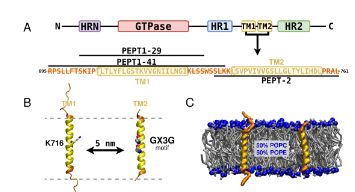Lys716 in the transmembrane domain of yeast mitofusin Fzo1 modulates anchoring and fusion
Raphaelle Versini, Marc Baaden, Laetitia Cavellini, Mickael M. Cohen, Antoine Taly, and Patrick F.J. Fuchs
Outer mitochondrial membrane (OMM) fusion is an important process for the cell and organism survival, as its dysfunction is linked to neurodegenerative diseases and cancer. The OMM fusion is mediated by members of the dynamin-related protein (DRP) family, named mitofusins. The exact mechanism by which the mitofusins contribute to these diseases, as well as the exact molecular fusion mechanism mediated by mitofusin, remains elusive. We have performed extensive multiscale molecular dynamics simulations using both coarse-grained and all-atom approaches to predict the dimerization of two transmembrane domain (TM) helices of the yeast mitofusin Fzo1. We identify specific residues, such as Lys716, that can modulate dimer stability. Comparison with a previous computational model reveals remarkable differences in helix crossing angles and interfacial contacts. Overall, however, the TM1-TM2 interface appears to be stable in the Martini and CHARMM force fields. Replica-exchange simulations further tune a detailed atomistic model, as confirmed by a remarkable agreement with an independent prediction of the Fzo1-Ugo1 complex by AlphaFold2. Functional implications, including a possible role of Lys716 that could affect membrane interactions during fusion, are suggested and consistent with experiments monitoring mitochondrial respiration of selected Fzo1 mutants.

